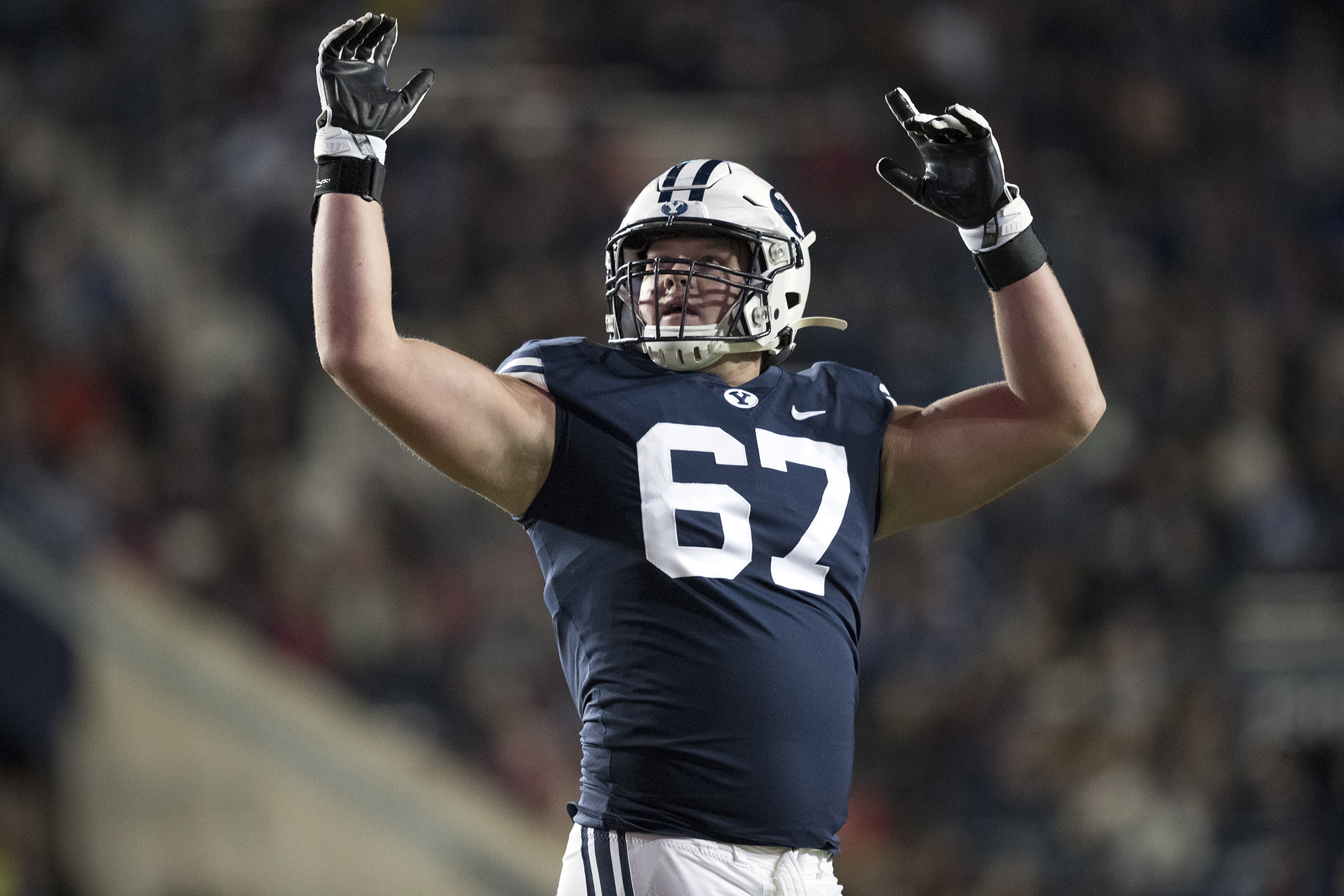While many expected the Panthers to target the offensive line before the 70th pick of the 2021 NFL Draft, after taking Jaycee Horn with the first pick the Panthers didn’t feel that the way the board developed justified taking an offensive lineman with their second pick. With that 70th pick, the Panthers selected BYU offensive lineman Brady Christensen, who excelled in protecting Zach Wilson’s blind side in 2020 and should be able to come in and compete to start right away.
What is less clear is exactly where he will end up playing, and this is something that Matt Rhule spoke to after the second day of draft:
“We think he’s a versatile player. A guy who can play outside and inside. We’ll wait to see when he gets here where exactly he fits. He comes from that pro-style offense at BYU, so he’s done the things that we are asking guys to do. He’s been doing it there. He’s a tackle candidate that can also go inside and play guard.” said Rhule.
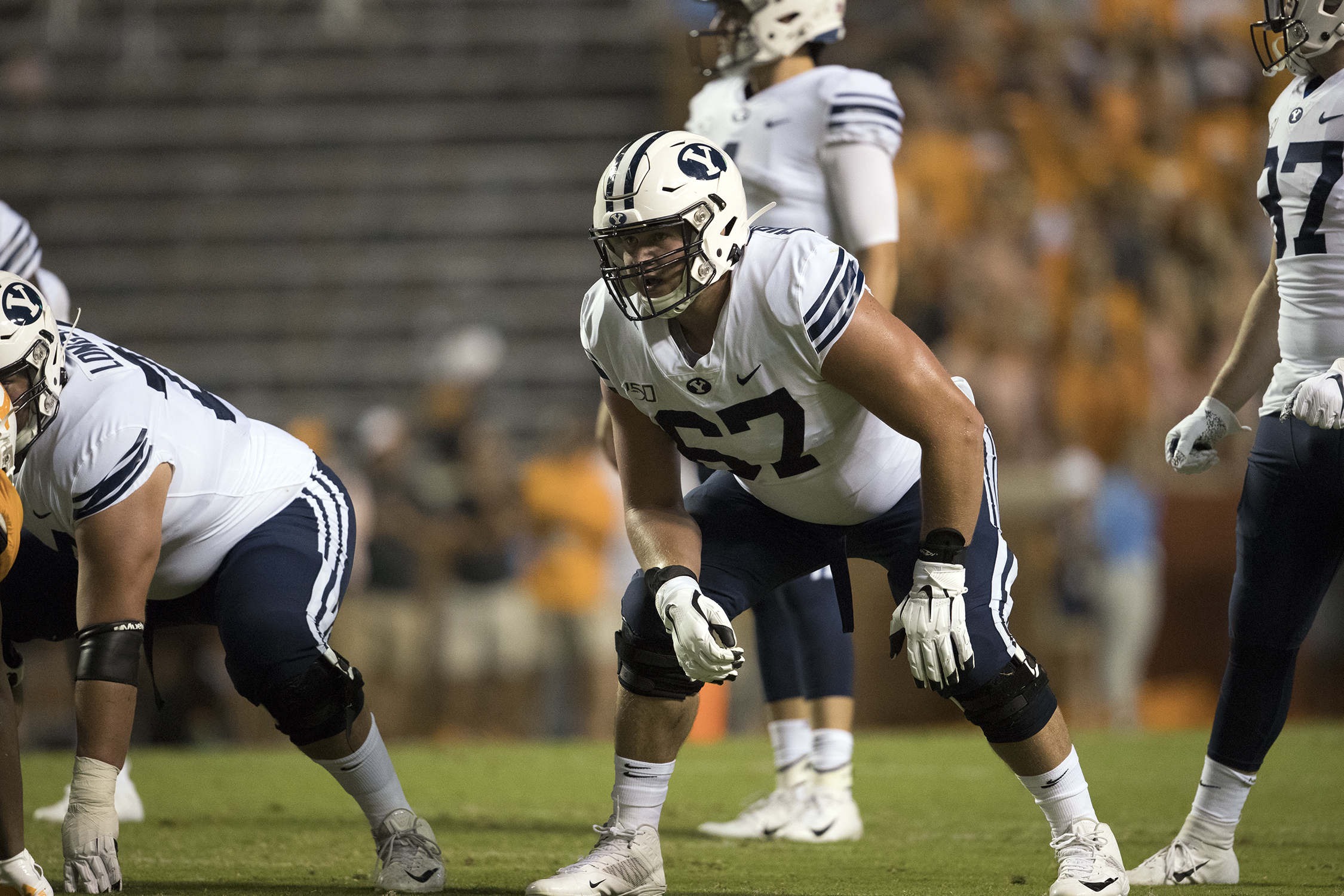
Photo Credit: Gabe Mayberry/BYU
Unsurprisingly, Christensen himself is fairly bullish about where he things he can play:
“I think I have proven that I can play left tackle at a high level and I feel like I can play at a high level in the NFL as well and for the Panthers” said Christensen, though he did also accept that he might be moved elsewhere, “With that being said, I know I can play all five (offensive line positions) at a high level. I feel like my athleticism will be able to transfer over to any position.”
So, with that in mind, let’s take a look both at what Christensen offers on tape and where that might mean he plays in the Panthers’ ever-evolving offensive line.
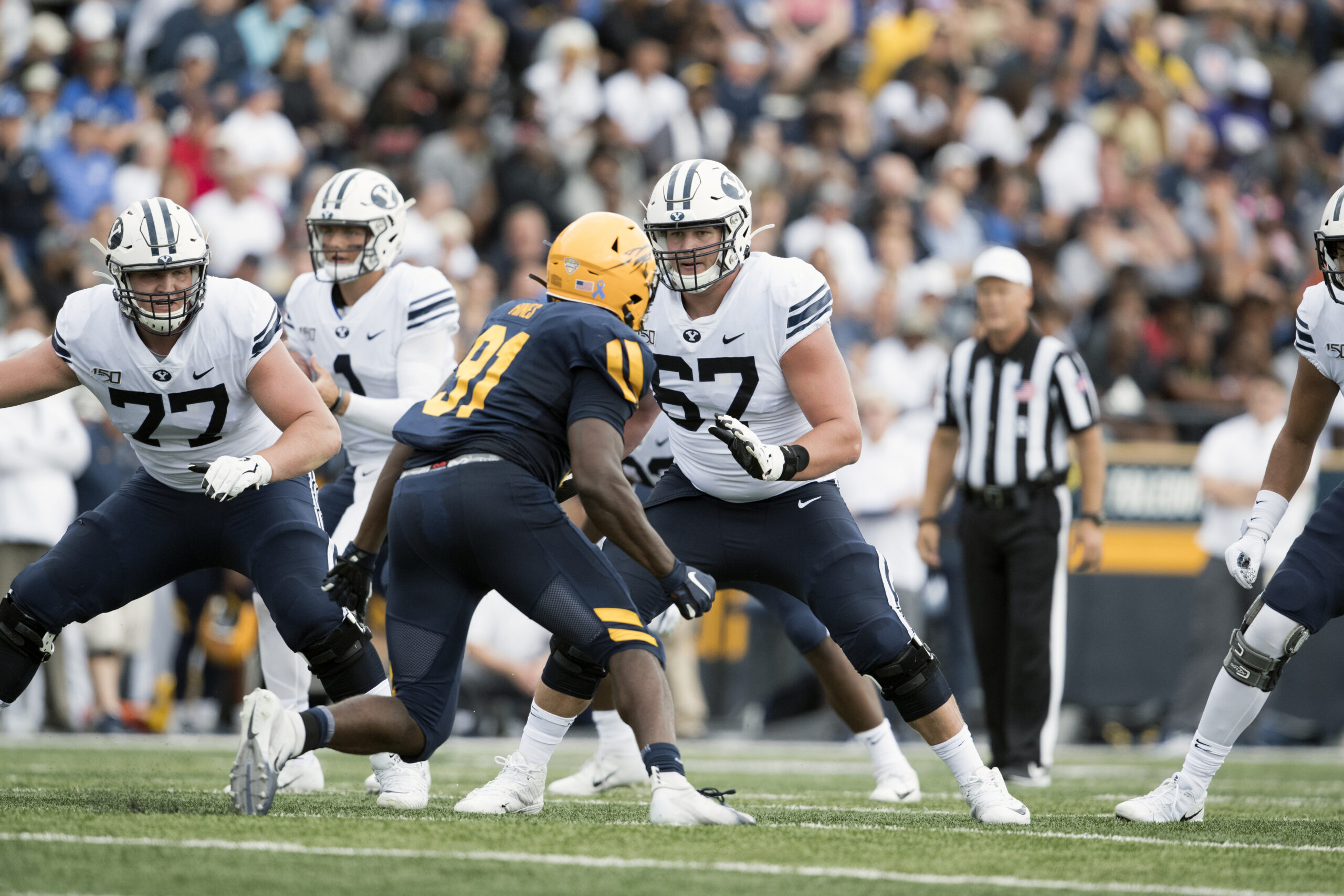
Photo Credit: Jaren Wilkey/BYU
Let’s start with pass protection, both because this is really the starting point with all offensive line prospects (if you can’t keep the QB upright you are not going to be allowed on the field) and because it is the part of his game that Christensen was quite to emphasize, “I think I’m an elite pass protector and I’ll be able to pass protect at a high level.”
The limiting factor for him to stay at tackle will be his foot speed, as if he can cover speed rushers around the edge then that’s probably going to mean he stays at tackle at the next level. This is something that Christensen mentioned as strength of his game:
“I feel like I have elite feet. When you have a wide-nine speed rusher, I feel like I can really get to my spot. It’s all about getting to the spot as a tackle and to be able to be in a position to win the block with balance, strength and leverage. I feel like that allows me to be in a really good position to win blocks pass protecting.” explained Christensen.
On tape, this is definitely something he does well a lot of the time, using nice short steps to work laterally while keeping his weight central while still being able to secure the edge:
However, while this wasn’t a persistent issue, there were times where he appeared to simply run out of foot speed:
Given that he didn’t face that many edge rushers who are going to be playing on Sundays in 2020, this wasn’t an issue that showed up a lot on tape, but if asked to face guys like Brian Burns, he is likely to be able to do much more than watch them run by without sacrificing control and balance.
This is really the important point, as the big issue for a lot of tackles in the NFL is not that they get run past all the time, but rather the technical issues that having to cover that speed then creates. Christensen is no exception to this, as when pushed for speed he tends to load weight onto his back leg:
This has two main effects. The first is that it makes it hard for him to recover against inside moves, as with all of his weight going backwards, he is unable to drive off his back legs to recover back inside, sometimes with slightly comical results:
Similarly, it also creates a vulnerability to rushers who are able to convert speed to power, and while the edge rusher here isn’t able to get his hands located well enough to properly execute this, there are flashes on tape where the better rushers he will face in the NFL are likely going to look to bull-rush him:
The important point here is not that he is bad and that he can be attacked in this way, but rather that the underlying cause of these issues is that he can struggle to keep pace around the edge at times. Every tackle in the NFL has an ultimate limit in this regard, the question with otherwise technically proficient tackle prospects in the NFL is where that limit lies.
For Christensen, this is really close to the limit. He probably can play left tackle in the NFL but is never going to be somebody who can be left one-on-one in obvious passing situations. Given that, he should be given a look at left tackle, as he can likely start there in the short term if he absolutely has to, but he is probably better suited to playing guard at the NFL level.
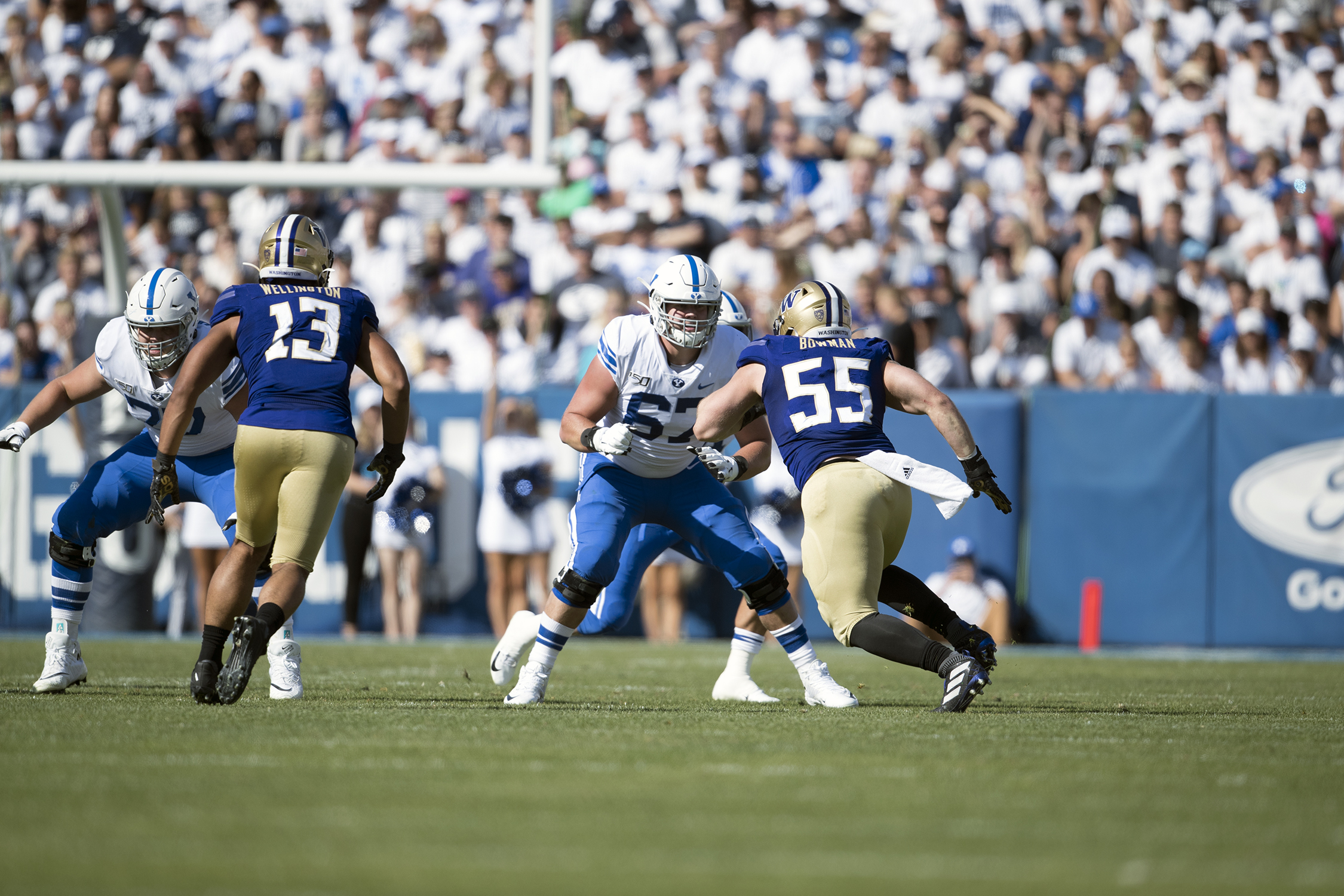
Photo by Jaren Wilkey/BYU
Wherever he plays, there are some other technical things he does well as well as some areas he should look to improve in. Occasionally he can get quite straight-legged:
Which has a number of knock-on effects as it can lead him to narrow his base which makes it hard for him to move laterally with defenders when engaged without being driven off-balance:
And can lead to him having to bend at the waist in order to counter power, which then works him off-balance:
It also makes it harder for him to recover laterally, as by straightening his legs he closes his hips which then makes it harder for him to pivot at the waist and means that when players are able to get lateral leverage against him it can be quite hard for him to recover:
However, pad level is something that most offensive line prospects (and a lot of NFL linemen) could stand to get better at, and if he does move inside to guard then the decreased pressure on him to cover laterally should allow him to play with better knee bend and slightly more open hips, which should both lower his center-of-gravity and improve his ability to twist to recover leverage.
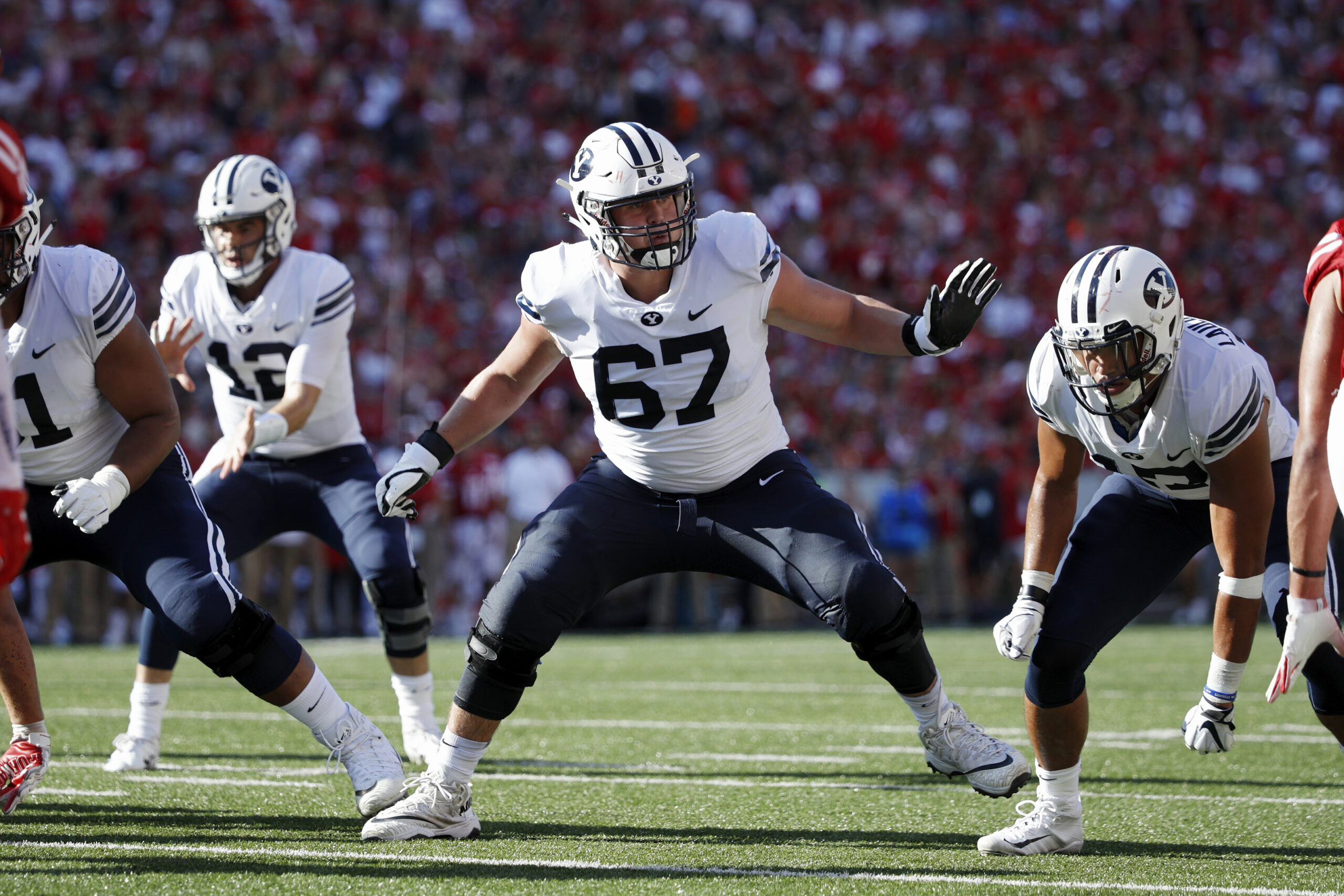
MADISON, WI – SEPTEMBER 15: Brady Christensen #67 of the BYU Cougars in action during the game against the Wisconsin Badgers at Camp Randall Stadium on September 15, 2018 in Madison, Wisconsin. BYU won 24-21. (Photo by Joe Robbins/Getty Images)
What will be under more pressure when working inside, however, is his hand usage, as with less space the focus becomes on securing and controlling rushers who will look to use their hands to generate lateral leverage. What was encouraging to see on tape was that he did a good job of hard setting, looking to crowd the rusher early in the play and use his strength and technique to make up for a lack of elite foot speed:
This is something that should both help him if he stays at tackle and bode well for his chances of moving inside to guard successfully. He is able to do this because of the way in which he is able to consistently locate his hands well to the frame of defenders with good arm extension, which makes it hard for them to shed to the block or to get hold of his frame to try and work him off balance:
However, there is room for further improvement still, something that Christensen acknowledged when talking to the media after his selection about where he thinks he can improve, “(I want to) continue to work on my hands, get better on my hands to be able to keep defenders at bay.”.
The main way he could do this is by improving his hand posture after the snap, as he has a tendency to let his hands drop and get wide, which both makes it harder for him to time and locate his punch to the frame of defender, but which also exposes his frame as an easy target:
This is more a matter of discipline than physical ability, but if he does move inside for the Panthers then this will be extremely important as if he does let his hands drop consistently when working inside, he will find it very hard to play with much control, as this can lead to him grabbing at the outside shoulders of defenders rather than being able to locate his hands inside:
While there are technical areas in which he needs refinement, though it is important to note that it is refinement that is required rather than any great leap in one area, there are two easily-underrated areas in which he excels in pass protection. For a start, he does a great job of the mental side of the game, understanding leverage and responsibility to handle attempts to scheme rushers free with ease:
He is also very good at winning ugly, and while this shouldn’t be the plan A for an offensive lineman, being able to draw your Ls as for as long as possible to give the QB time to get the ball out is a real skill:
No offensive lineman is going to win every rep, but what is a real killer for an offensive line is quick pressure where the quarterback has no possibility of doing anything but taking a sack (see Jets, New York), and players who are able to eliminate these plays from their tape are going to be able to survive as starters in the NFL if nothing else.
As a pass protector then, Christensen does do a lot of things well, he shows good hand location and arm extension, with good footwork and largely good pad level. However, his ultimate foot speed covering rushers around the edge might make it hard for him to stay at tackle at the NFL level, but if he does move inside then his technical proficiency as a pass rusher should translate well and allow him to see the field early.
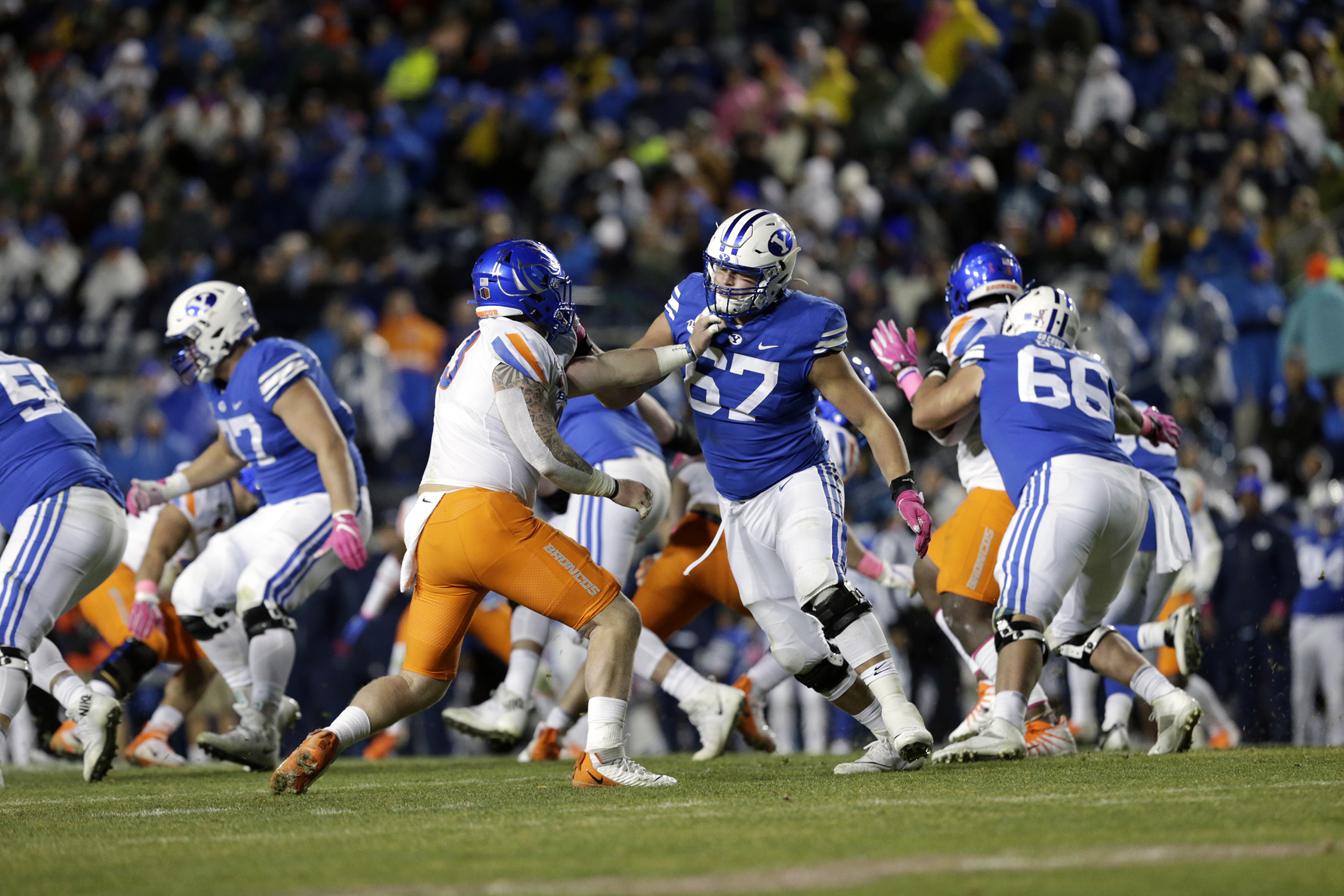
Photo by Claire Gentry/BYU
In the run game, while he isn’t a mauler, he has enough power to generate push up front, and this should also help him to anchor if he does move inside:
And here his quick feet are also put to good use, as he is able to work around defenders to create blocks laterally, something that will be a valuable skill in what is expected to be more of a directional blocking scheme for the Panthers in 2021:
What is also noticeable on this second play is that while he isn’t able to get all the way around the blocker with foot speed, he is still able to make an effective block as with good hand location and arm extension the defender is unable to work into a leveraged position, and this good arm extension and hand placement is a fairly consistent feature of his run blocking:
However, as in the passing game, he can sometimes let his arms get a little wide, leading him to strike to the outside shoulder of the defender rather than to their frame:
He could also stand to improve his knee bend a bit, as this can create some issues in controlling blocks and generating as much power as he otherwise would:
And this can also lead to him playing with a narrow base which makes it very hard for him to recover to lateral changes in direction:
He can also contribute out in space, both on screens:
And when working to the second level in the run game:
As a run blocker, Christensen will need to continue to refine some things technically and would likely be a poor fit in a more power-based run scheme, but in a directional scheme he should be a good run blocker either at guard or at tackle.
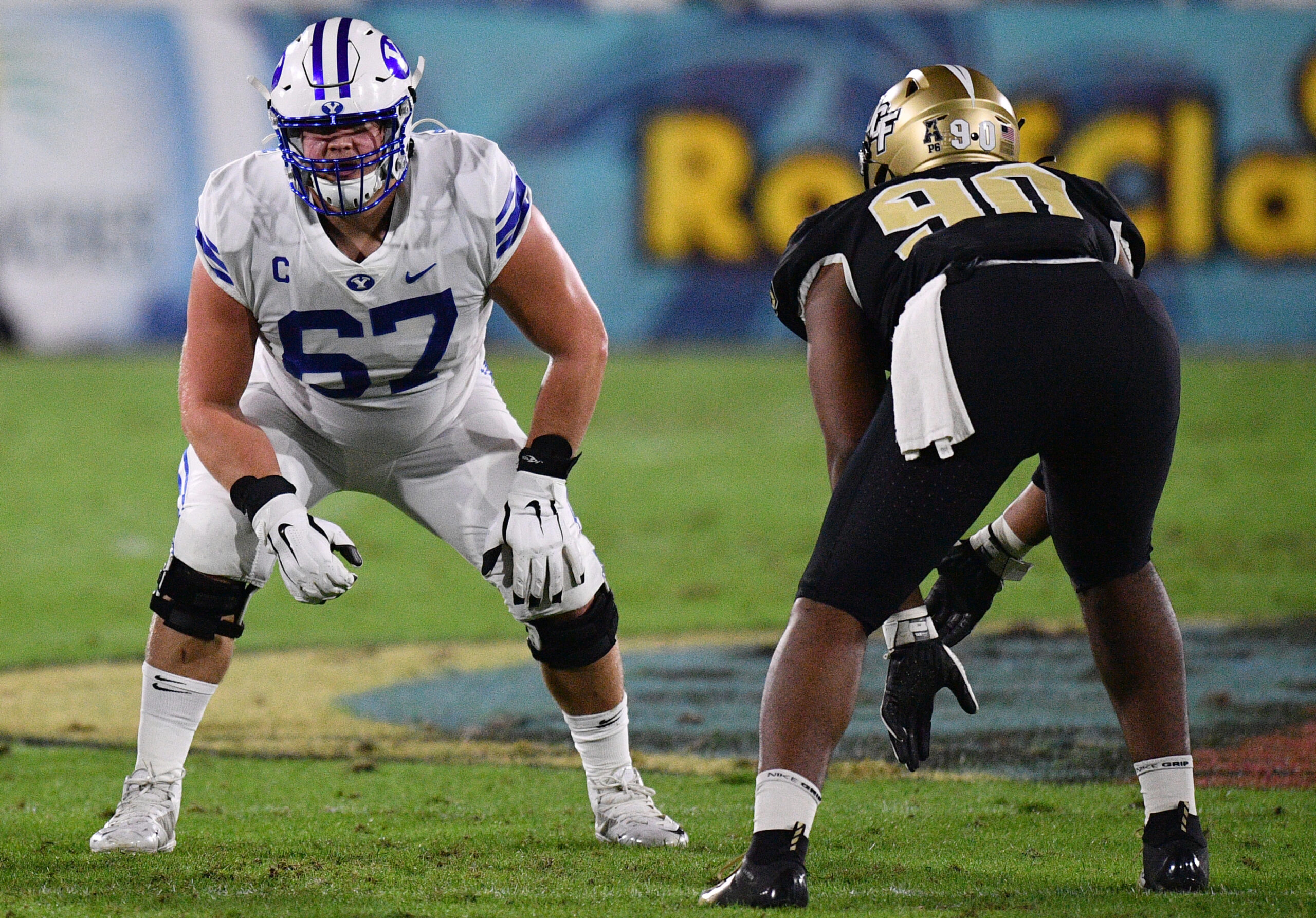
BOCA RATON, FLORIDA – DECEMBER 22: (L-R) Blake Freeland #71, Chandon Herring #77, Connor Pay #70, and Tristen Hoge #69 of the Brigham Young Cougars celebrate a touchdown in the first half against the Central Florida Knights at FAU Stadium on December 22, 2020 in Boca Raton, Florida. (Photo by Mark Brown/Getty Images)
Christensen’s age should cause some hesitation when projecting how much he is likely to develop in the NFL, and while the Panthers would be foolish not to try him at tackle during training camp, they would also be foolish to have an expectation of him starting there in 2021. Given his age, the hope would certainly be that he sees the field sooner and later, and he should be among the favorites to win a spot at guard if he doesn’t ultimately stick at tackle, while also offering insurance at both tackle spots both this season and when it comes to next offseason.
(Top photo via Jaren Wilkey/BYU Athletics)

